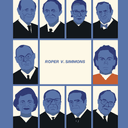
As the death penalty continues to wilt across the country, whatever penological justification it once purportedly served is dying as well, say capital punishment scholars Carol Steiker and Jordan Steiker (pictured). In their new article The Rise, Fall, and Afterlife of the Death Penalty in the United States in the January 2020 Annual Review of Criminology, the Steikers examine four central issues in the rise and fall of the death penalty in the United States and explore what an American criminal justice system might look like after the punishment’s demise.
Carol Steiker is the Henry J. Friendly Professor of Law and Faculty Co-Director of the Criminal Justice Policy Program at Harvard Law School. Her brother, Jordan Steiker, is the Judge Robert M. Parker Endowed Chair in Law and Director of the Capital Punishment Center at the University of Texas School of Law. Both served as law clerks to the late U.S. Supreme Court Justice Thurgood Marshall and together they have written extensively on death-penalty issues, including the acclaimed 2016 book, Courting Death: The Supreme Court and Capital Punishment.
In the Criminology Review article, the siblings address the United States’ retention of the death penalty when all other developed Western democracies have eliminated it; the role of race and the legacy of discrimination in the administration of the death penalty; the death penalty’s “sudden and profound withering” over the last two decades; and the broader impact abolition of the death penalty would have on the United States criminal legal system.
After reviewing these four main issues, the Steikers conclude that “by every measure, the American death penalty is withering, reflecting its increasing tension with contemporary moral standards and undercutting its ability to serve any penological purpose (such as deterrence or retribution) necessary to justify its retention.”
Why the Modern U.S. Approach to Capital Punishment Differs From Other Western Democracies
In the opening section of their article, the Steikers examine political and cultural factors in the United States that led to the retention of capital punishment in this country while, in the last 40 years, other Western democracies eliminated the death penalty. They address the arguments advanced by other scholars, who attribute this divergence to such factors as “association between a jurisdiction’s history of vigilante conduct … and its propensity to conduct executions”; the direct connection between “America’s history of slavery, lynching, and Jim Crow [and] harsh criminal and capital punishment”; and the “winner-take-all structure of the American political system” that “produces single-issue campaigns” like crime. Ultimately, the Steikers conclude that “[w]hat is truly distinctive — indeed, unique — about the modern era of the American death penalty is how central a role the Supreme Court and the Constitution have played in virtually every development.… This experiment with constitutional regulation of the death penalty more than the mere fact of continued retention, is what most sets the United States apart from its peer countries.”
Race and the Death Penalty
“Race has long influenced the operation of the American death penalty system,” the Steikers write. The second section of their article explores the inextricable link between the two. After emancipation, the Reconstruction Era produced “an extraordinary rise in lynching, which became a more prominent and frequent means of killing blacks suspected of crime (or other transgressions) than official executions.” Societal concerns about lynching — both a desire to reduce the number of lynchings and embarrassment at the image of America it created — “helped cement death penalty retentionism,” they say. “They note that “[i]n many jurisdictions, particularly in the Deep South, the dividing line between lynching and capital punishment was not so stark. In some cases, mobs were at the courthouse steps, or even in the courtroom, insisting on the swift declaration of a death sentence and imposition of an execution.”
Multiple studies demonstrate the continuing impact of race in the modern administration of capital punishment, they say, most clearly in the form of victim preference. These studies demonstrate that a defendant — black or white — is much more likely to be sentenced to death and executed if the victim is white, but the evidence suggests that “[r]acial discrimination … permeate[s] all phases of capital litigation, including investigation, charging decisions, jury selection, and sentencing.”
The Decline of the Death Penalty
Next, the Steikers address the causes and significance of the decline of the death penalty in the United States, reflected by the lower number of executions and new death sentences. The Steikers attribute the decline in death sentences to a combination of factors, including “the decline in murder rates,” “the increased professionalism of the capital defense bar,” and overall “declines in seeking the death penalty.” They consider litigation over state lethal-injection protocols to be a “primary obstacle” to executions taking place, contributing to the generationally low numbers of executions in recent years. “Some states lack the drugs to carry out executions; some states have no approved protocol; concerns about botched executions have diminished the appetite for executions; and the presence of the lethal injection controversy allows actors (e.g., judges, state officials) who have reservations about capital punishment apart from the risks of lethal injection to limit or preclude executions,” they say. They also suggest that “[t]he remarkable decline in death sentences suggests that the currently low number of executions is unsustainable in the near term, and we should expect a significant decline in executions within the next two decades.”
What’s Next for the United States?
Finally, the Steikers explore what the abolition of the death penalty in the United States would mean for the American criminal legal system in the future. Noting that “states’ own analyses of the relative cost of capital and noncapital prosecutions revealed that capital prosecutions were substantially more expensive,” they write that “[o]ne unambiguous gain will be the costs savings that abolition of the death penalty will entail for many jurisdictions.” They also write that abolition of the death penalty will call into question the United States’ outlier status in sentencing people to life without the possibility of parole (LWOP), a sentence that many death-penalty abolitionists begrudgingly support. They write, “[t]he eradication of the death penalty would free abolitionists from their reluctant support of LWOP and allow a more honest assessment of the cruelty of LWOP and other extraordinarily harsh sentences.”
The authors conclude that “even without capital punishment, the vigorous use of other extremely harsh punishments (like LWOP) and the maintenance of degrading conditions of incarceration (such as excessive use of solitary confinement and tolerance of sexual violence) stand in the way of a full embrace of human dignity in punishment practices.… The dismantling of the death penalty will not immediately or inevitably do much to reverse the massive scale of American imprisonment.”
Carol S. Steiker and Jordan M. Steiker, The Rise, Fall, and Afterlife of the Death Penalty in the United States, Annual Review of Criminology, January 2020.


